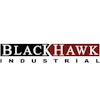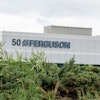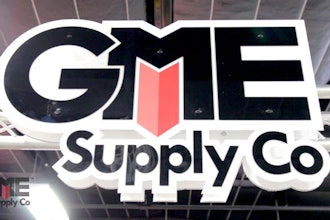Amherst, NY - Columbus McKinnon Corporation, a leading designer, manufacturer and marketer of material handling products, today announced financial results for its fiscal 2014 first quarter which ended June 30, 2013.
Timothy T. Tevens, President and Chief Executive Officer, commented, “We achieved great success in driving margin expansion in the quarter as we realized one of the highest gross margin levels in our recent history. We are making solid headway in increasing our sales volumes in emerging markets, specifically Asia, the Middle East, Latin America and Eastern Europe. These gains have helped to offset the recessionary industrial economy in Europe. Our Lean Business System has also been successful in driving out waste and therefore cost from our operating structure, which has improved our margins on a lower sales base.”
Net sales for the first quarter of fiscal 2014 were $138.9 million, down $14.1 million, or 9.2%, from the prior-year period as one additional shipping day and improved pricing were more than offset by the decline in volume, particularly in Europe. Excluding the effects of acquisitions and divestitures and foreign currency translation, sales declined by $10.1 million, or 6.6%, in the quarter.
U.S. sales, which comprised 59% of total sales, were down by $7.9 million, or 8.8%, to $82.0 million compared with $90.0 million for the first quarter of fiscal 2013. Lower volume and the $4.5 million impact of the crane business divestiture in August 2012 more than offset improved pricing and one additional shipping day. Sales outside of the U.S. were down $6.2 million, or 9.8%, to $56.9 million, primarily on lower sales volume. The additional shipping day, improved pricing and the effect of a small acquisition in Austria with approximately $10 million in annual revenue somewhat offset the volume decline. The Austrian acquisition, which was completed on June 1, 2013, has been a value-added partner of the Company in the lifting industry in the Austrian market for over 20 years. This acquisition enables the Company to better leverage sales in this and other regions of the world and does not have a material effect on earnings. Foreign currency translation had a negative impact of $0.2 million on sales during the quarter.
The fluctuation in sales for the first quarter of fiscal 2014 compared with the first quarter of fiscal 2013 is summarized as follows:
| ($ in millions) | $Change | % Change | |||||||||
| Volume | (15.9 | ) | (10.4 | ) % | |||||||
| Acquisitions & divestitures | (3.8 | ) | (2.5 | ) % | |||||||
| Foreign currency translation | (0.2 | ) | (0.1 | ) % | |||||||
| Additional shipping day | 2.4 | 1.6 | % | ||||||||
| Pricing | 3.4 | 2.2 | % | ||||||||
| Total | $ | (14.1 | ) | (9.2 | ) % | ||||||
Pricing and productivity drove margin improvements
Gross profit in the first quarter of fiscal 2014 declined slightly to $43.5 million, down just $0.3 million from the prior-year period. As a percentage of sales, gross margin expanded 270 basis points to 31.3% compared with 28.6% for the prior-year period. Productivity improvements and pricing drove margin expansion, more than offsetting the impact of lower volume. The prior-year’s first quarter had the benefit of a $1.8 million brokerage fee, or 80 basis points, that was accounted for on a net revenue basis with no associated cost of sales.
Selling expense was $16.7 million, up 2.3%, or $0.4 million, from the same period of the prior year. Increased selling expense was related to the Austrian acquisition that was completed during the quarter and investments in emerging markets. As a percent of revenue, selling expense was 12.1% on measurably lower revenue compared with 10.7% in the same period last year.
General and administrative (G&A) expense was $12.8 million, down from $14.2 million in the prior-year period, which included approximately $0.8 million of one-time costs. As a percent of sales, G&A was 9.3%, flat when compared with the prior-year period.
Operating income in the fiscal 2014 first quarter was up $0.7 million, or 5.1%, to $13.4 million when compared with the first quarter of fiscal 2013. Operating margin expanded 130 basis points to 9.7% of sales.
Income before tax expense was negatively impacted by approximately $1.0 million as a result of the realized change in foreign currency exchange when compared with the prior year. The effective tax rate in the 2014 first quarter was 29.6% compared with 17.4% in the prior-year period. The prior-year period effective tax rate was impacted by a valuation allowance on deferred tax assets, primarily in the U.S.
First quarter fiscal 2014 net income was $7.0 million, or $0.35 per diluted share, down from $8.4 million or $0.43 per diluted share in the prior-year period. Adjusted for the current quarter’s tax rate, fiscal 2013’s first quarter earnings per diluted share were $0.37. Further details of the reconciliation of GAAP EPS to adjusted EPS are shown on page 9 of this release.
Balance sheet provides significant financial flexibility
Cash used in operations was $1.9 million. This was primarily due to an increase in inventories as a result of a higher level of project type orders, as well as an increase in prepaid expenses due to the timing of insurance renewals, offset by lower trade receivables. Net cash used for investing activities included $5.8 million for the Austrian acquisition previously mentioned as well as normal capital expenditures. As a result, cash and cash equivalents decreased by $11.3 million to $110.4 million at the end of fiscal 2014’s first quarter, from $121.7 million at March 31, 2013. Working capital as a percentage of sales was 20.2% at the end of the first quarter of 2014, up from 19.8% at the end of the first quarter of 2013 and 18.3% at the end of the trailing fourth quarter of fiscal 2013.
Capital expenditures for the first quarter of fiscal 2014 were $3.6 million compared with $1.7 million in the prior-year period. Approximately $0.7 million was associated with the implementation of a new enterprise management system. The Company continues to expect fiscal 2014 capital spending to be in the range of $20 million to $25 million.
Gross debt at June 30, 2013 was $151.9 million. Debt, net of cash, was $41.5 million, or 14.4% of net total capitalization, compared with $30.4 million, or 11.2% of net total capitalization, at March 31, 2013.
Continued growth in emerging economies and strong performance in key vertical markets expected to offset slow economic growth
Backlog was $92.0 million at June 30, 2013 compared with $99.0 million at March 31, 2013. Although the time to convert the majority of backlog to sales typically ranges from one day to a few weeks, backlog can include project-type orders from customers that have defined deliveries that may extend out 12 to 24 months. As of June 30, 2013, approximately $34.6 million of backlog, or 37.6%, was scheduled for shipment beyond September 30, 2013.
Both U.S. and Eurozone capacity utilization are leading market indicators for the Company. U.S. industrial capacity utilization was 76.8% in June 2013, compared with 76.5% a year ago, and 77.0% in March 2013. Eurozone capacity utilization was 77.5% in the quarter ended June 30, 2013, down from 80.0% during the quarter ended June 30, 2012, but unchanged from the quarter ended March 31, 2013. The European indicator reflects the recessionary environment in the Eurozone, while the U.S. remains flat. The Company’s sales tend to lag changes in these indicators by one to two quarters.
Mr. Tevens concluded, "We remain committed to improving and sustaining our earnings and have made great strides over this past year to enable strong margins. Additionally, there are early signs that our industrial markets are improving in Europe. For example, we have seen early indications of increasing bidding activity in our European project business, which is a positive sign in this uncertain economy. And, we expect the U.S. to grow modestly during the remainder of the fiscal year. We continue to realize growth in emerging economies, despite concerns of China’s slowed growth, as we take market share in that region.”


















